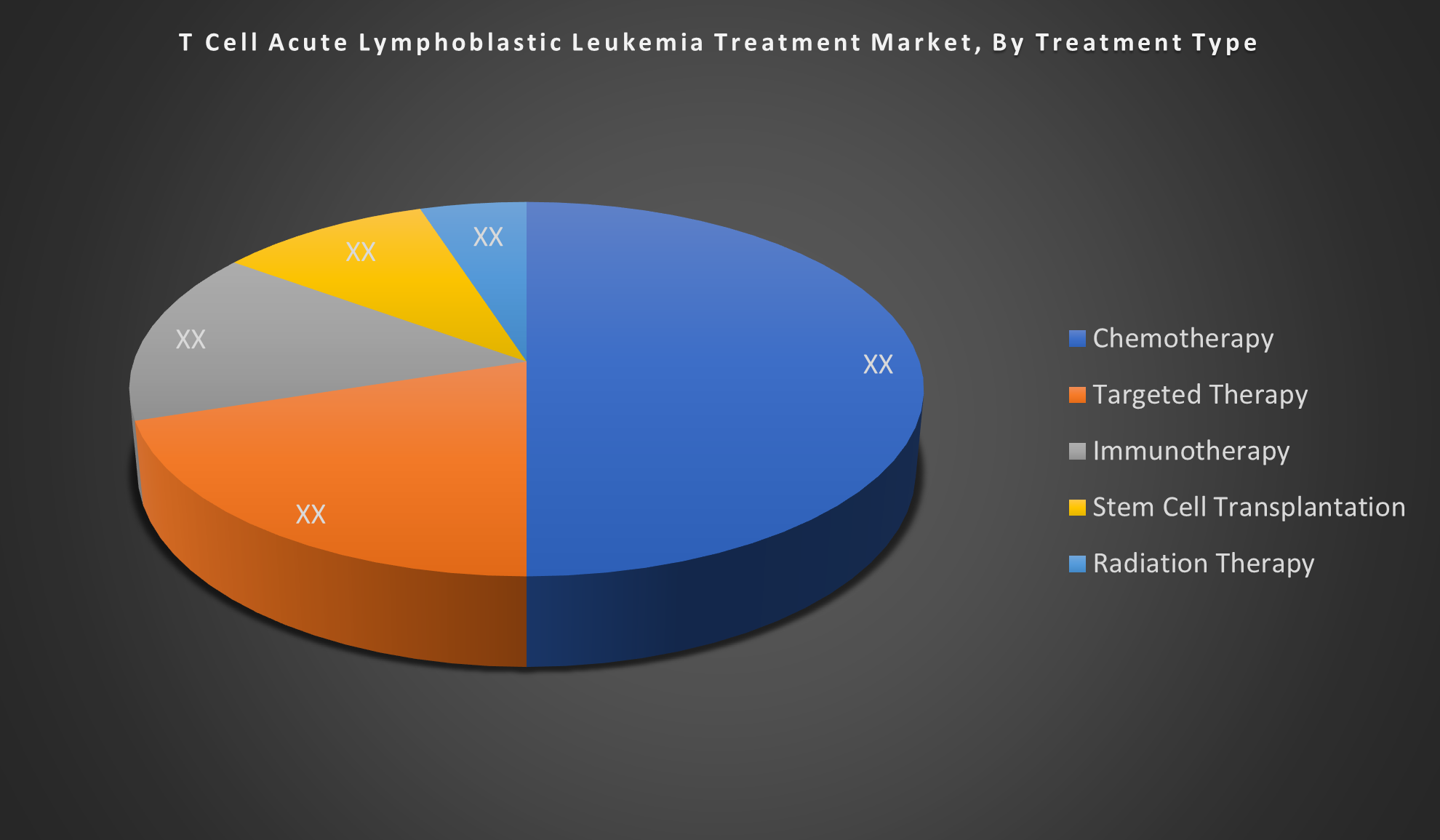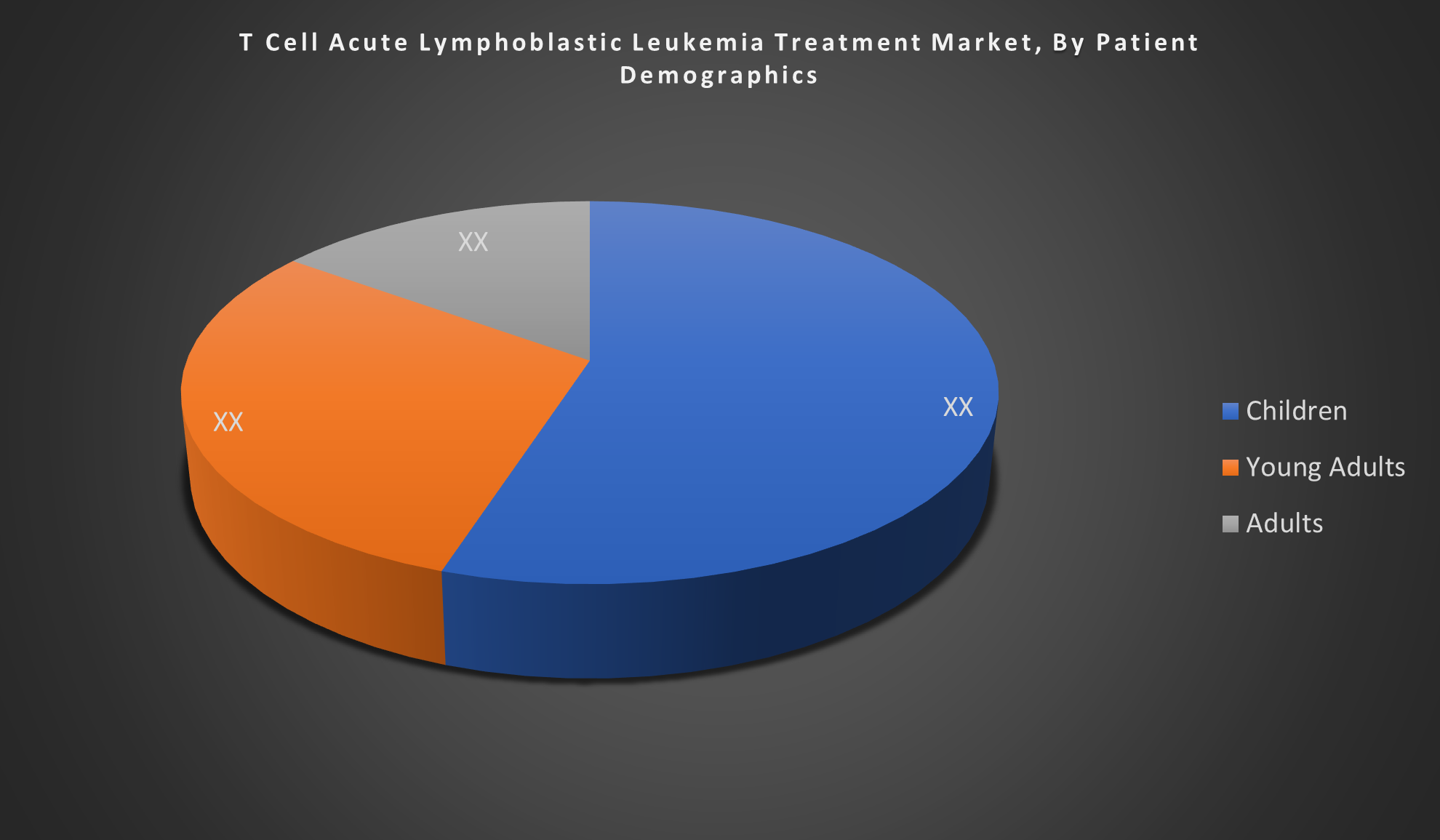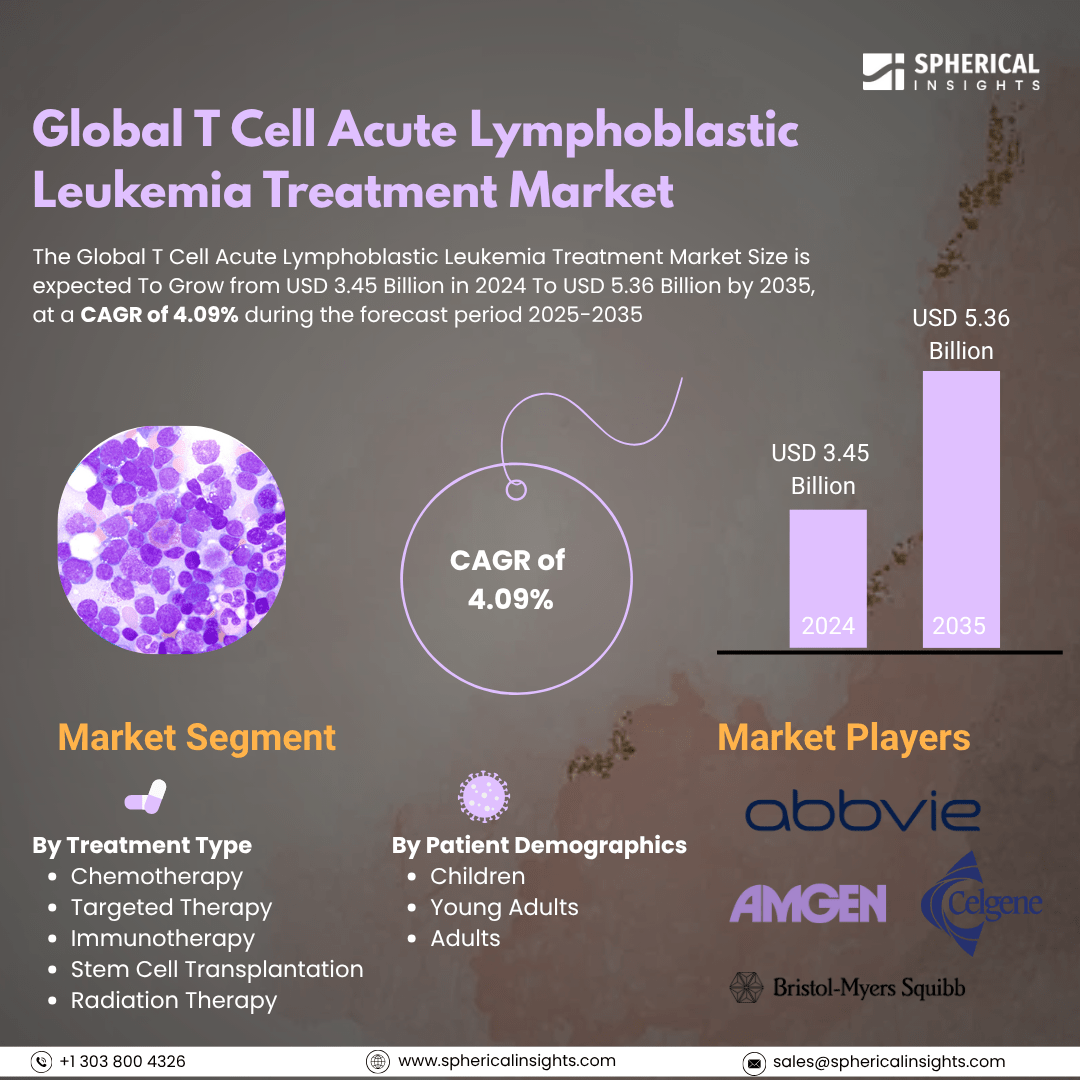- As per Spherical Insights & Consulting, The Global T Cell Acute Lymphoblastic Leukemia Treatment Market Size is Expected To Grow from USD 3.45 Billion in 2024 to USD 5.36 Billion by 2035, at a CAGR of 4.09% during the forecast period 2025-2035, owing to the launch of new therapies in the market and the rise in the number of cases
-
The leading T Cell Acute Lymphoblastic Leukemia Treatment Market Companies such as AbbVie, Amgen, Bristol Myers Squibb, Celgene, Gilead Sciences (Kite Pharma), GlaxoSmithKline, Johnson & Johnson, Novartis, Pfizer, Roche, Sanofi, Takeda, Erytech Pharma, Spectrum Pharmaceuticals, Kyowa Kirin, and Others

T Cell Acute Lymphoblastic Leukemia Market: Understanding and Treatment Algorithm:
T-cell acute lymphoblastic leukemia (T-ALL) is a rare and aggressive cancer of the blood and bone marrow, where immature T-cells multiply uncontrollably. It primarily affects children and young adults, causing symptoms like fatigue, bleeding, and infections due to disrupted normal blood cell production.
T Cell Acute Lymphoblastic Leukemia Diagnosis:
Diagnosis of T-cell acute lymphoblastic leukemia involves blood tests, bone marrow biopsy, and immunophenotyping to identify abnormal T-cell markers. Additional tests like cytogenetic analysis, lumbar puncture, and imaging scans help assess central nervous system involvement and detect chromosomal abnormalities, guiding prognosis and personalized treatment planning for patients.
T Cell Acute Lymphoblastic Leukemia Treatment
Treatment for T-cell acute lymphoblastic leukemia typically includes multi-phase chemotherapy induction, consolidation, and maintenance to eliminate cancerous cells. Additional options like targeted therapies, immunotherapy, and stem cell transplantation may be used for high-risk or relapsed cases. Central nervous system prophylaxis is also critical to prevent leukemia spread to the brain and spine.
T Cell Acute Lymphoblastic Leukemia Treatment Epidemiology
The disease epidemiology covered in the report provides historical as well as forecasted epidemiology segmented by Total Diagnosed Incident Population of T Cell Acute Lymphoblastic Leukemia Treatment, Gender-specific Diagnosed Incidence of T Cell Acute Lymphoblastic Leukemia Treatment, Type-specific Diagnosed Incidence of T Cell Acute Lymphoblastic Leukemia Treatment, Age-specific Diagnosed Incidence of T Cell Acute Lymphoblastic Leukemia Treatment, Diagnosed Incident Population based on Primary Site of T Cell Acute Lymphoblastic Leukemia Treatment, and Diagnosed Incident Population based on Histologic Classification of T Cell Acute Lymphoblastic Leukemia Treatment Tumour in the global market covering North America, Europe, Asia-Pacific, Latin America, the Middle East, and Africa from 2024 to 2035.
Principal Insights
This section offers a global overview of T cell acute lymphoblastic leukemia treatment epidemiology in major markets worldwide.
Country Wise- T Cell Acute Lymphoblastic Leukemia Treatment Multiforme Epidemiology
- The epidemiology segment provides T Cell Acute Lymphoblastic Leukemia prevalence data and findings across key regions worldwide, including North America, Europe (Germany, France, Italy, Spain, and the United Kingdom), Asia-Pacific (including Japan), Latin America, the Middle East, and Africa.
T Cell Acute Lymphoblastic Leukemia Treatment Recent Developments:
- In May 2023, Shorla Oncology and EVERSANA announced the commercial launch of Nelarabine Injection across the U.S. for treating pediatric and adult T cell leukemia and lymphoma patients whose disease had failed at least two prior chemotherapy regimens. The launch addressed historical drug shortages and improved treatment availability.
T Cell Acute Lymphoblastic Leukemia Treatment Marketed Drugs:
- Nelarabine: Shorla Oncology / GlaxoSmithKline
Nelarabine is a purine nucleoside analog specifically approved for relapsed or refractory T-cell ALL and T-cell lymphoblastic lymphoma. It works by interfering with DNA synthesis in cancer cells, leading to apoptosis. FDA-approved, it is used particularly in pediatric and young adult patients.
- Elspar (Asparaginase): Jazz Pharmaceuticals
Elspar depletes asparagine, an amino acid leukemia cells need to survive. It is used in multi-agent chemotherapy regimens for ALL, including T-ALL. Though not specific to T-cell type, it plays a vital role in standard treatment protocols.
Though primarily indicated for B-cell ALL, blinatumomab a bispecific T-cell engager (BiTE) has been studied off-label in T-ALL for its T-cell redirection properties. It activates cytotoxic T-cells against leukemia cells, offering promise in relapsed settings.
T Cell Acute Lymphoblastic Leukemia: Emerging Therapies
- BNT327: It is a bispecific antibody in late-stage trials for T Cell Acute Lymphoblastic Leukemia treatment. It targets two immune checkpoints to enhance T-cell activation and tumor response, aiming to improve outcomes in patients resistant to standard PD-1/PD-L1 therapies.
- Daratumumab: It is a monoclonal antibody targeting CD38, currently being investigated in clinical trials for relapsed/refractory T-ALL. By binding to CD38 on leukemic cells, it promotes immune-mediated cell death and has shown promising results in combination with chemotherapy.
- Moxe: It is an anti-CD22 recombinant immunotoxin under evaluation for T-ALL. It delivers a toxin selectively to CD22-expressing leukemic cells, causing targeted cell death. Early-phase trials are exploring its efficacy in relapsed/refractory T-ALL.
- Cerdulatinib: It is a dual SYK/JAK kinase inhibitor in clinical development for T-ALL. By inhibiting key signaling pathways essential for leukemia cell survival, it aims to overcome resistance to conventional therapies.
T Cell Acute Lymphoblastic Leukemia Treatment Market Outlook
- The T cell acute lymphoblastic leukemia (T-ALL) treatment market refers to the global commercial space involving the development, production, and sale of pharmaceutical drugs, biologics, and advanced therapies specifically designed to treat T-ALL a subtype of acute lymphoblastic leukemia characterized by malignant transformation of immature T-cell lymphoblasts.
- The market is driven by the increasing incidence of T-ALL, ongoing advancements in precision medicine, and the need for effective treatments for relapsed or refractory cases. It includes established FDA-approved drugs, emerging pipeline candidates, and evolving treatment protocols aimed at improving patient survival and quality of life.
- Opportunities in the T-ALL treatment market include development of novel targeted therapies, expanding CAR-T and bispecific antibody platforms, growing pediatric and adult patient populations, advancements in gene editing technologies, and increasing investments in research to address treatment-resistant and relapsed T-ALL cases worldwide.
- Global government initiatives support T-ALL treatment through funding cancer research, promoting access to innovative therapies, implementing cancer control programs, and encouraging collaborations to improve diagnosis, treatment, and patient outcomes worldwide.
- Challenges include drug resistance, limited targeted therapies, high treatment costs, side effects, and difficulty treating relapsed or refractory T-ALL patients.
- The T-ALL treatment market is projected to grow due to increasing disease prevalence and advancements in targeted and immunotherapies.
T Cell Acute Lymphoblastic Leukemia Treatment Market Segmentation
By Treatment Type:
- Chemotherapy
- Targeted Therapy
- Immunotherapy
- Stem Cell Transplantation
- Radiation Therapy

The Chemotherapy segment holds the largest share in the global T-ALL treatment market due to its longstanding as the standard first-line treatment. Its widespread availability, established efficacy, and integration into most treatment protocols make it the dominant therapy despite the growing presence of targeted and immunotherapies.
By Patient Demographics:
- Children
- Young Adults
- Adults

The Children’s segment holds the largest share in the T-ALL treatment market due to the higher incidence of T-ALL in pediatric populations and the emphasis on aggressive, tailored treatment protocols in children, resulting in greater demand for specialized therapies and supportive care in this demographic.
Regional Segment Analysis of the T Cell Acute Lymphoblastic Leukemia Treatment Market
North America currently holds the largest share of the T-ALL treatment market, primarily driven by the United States. This dominance is attributed to the region’s advanced healthcare infrastructure, well-established oncology treatment centers, high healthcare expenditure, and early adoption of innovative therapies. Robust government funding for cancer research, strong presence of major pharmaceutical companies, and widespread availability of FDA-approved drugs contribute to sustained market leadership. Additionally, increasing awareness, better diagnostic capabilities, and comprehensive insurance coverage further support treatment accessibility and market growth.
The Asia-Pacific region is the fastest-growing market for T-ALL treatment, fueled by rising incidence rates of leukemia, expanding healthcare infrastructure, and increasing government initiatives to improve cancer care. Growing awareness and accessibility to novel therapies, along with improving reimbursement policies, are driving market expansion. Rapid urbanization and improving diagnostic facilities contribute to early detection and treatment. Moreover, expanding clinical trial activities and increasing investments by global pharmaceutical companies to capture this emerging market add momentum. Countries like China and India are key contributors to this growth due to their large patient populations.
T Cell Acute Lymphoblastic Leukemia Treatment Market Key Companies
- AbbVie
- Amgen
- Bristol Myers Squibb
- Celgene
- Gilead Sciences (Kite Pharma)
- GlaxoSmithKline
- Johnson & Johnson
- Novartis
- Pfizer
- Roche
- Sanofi
- Takeda
- Erytech Pharma
- Spectrum Pharmaceuticals
- Kyowa Kirin
- Others
T Cell Acute Lymphoblastic Leukemia Therapeutics Market Report Scope
- The T Cell Acute Lymphoblastic Leukemia therapeutics market report provides a detailed overview, covering its causes, symptoms, disease progression, and existing treatment options.
- Detailed insights into T Cell Acute Lymphoblastic Leukemia Treatment’s epidemiology and therapeutic approaches are included.
- Additionally, a comprehensive review of existing and emerging T Cell Acute Lymphoblastic Leukemia therapies is provided, including an evaluation of new treatments expected to influence the current T Cell Acute Lymphoblastic Leukemia treatment market landscape.
- The report includes a detailed review of the T Cell Acute Lymphoblastic Leukemia therapeutics market, both historical and forecasted, highlighting the global drug reach.
- The Patient-Based T Cell Acute Lymphoblastic Leukemia Treatment Market Forecasting report offers valuable insights into trends shaping the global T Cell Acute Lymphoblastic Leukemia Treatment market, helping to develop effective business strategies.
T Cell Acute Lymphoblastic Leukemia Treatment Market Report Insights
- Forecasting Market Trends Based on Patient Data and Disease Rates
- T Cell Acute Lymphoblastic Leukemia Therapeutic Approaches in T Cell Acute Lymphoblastic Leukemia Treatment
- Review Of Drugs in Development for T Cell Acute Lymphoblastic Leukemia Treatment
- Market, Growth, and Trends in T Cell Acute Lymphoblastic Leukemia Treatment
- Market Opportunities in T Cell Acute Lymphoblastic Leukemia Treatment
- Effects Of Future Therapies on T Cell Acute Lymphoblastic Leukemia Treatment.
T Cell Acute Lymphoblastic Leukemia Treatment Market Report Key Strengths
- 15 Years T Cell Acute Lymphoblastic Leukemia Treatment Market Forecast
- Global Coverage
- T Cell Acute Lymphoblastic Leukemia Treatment Epidemiology Segmentation
- Key Cross Competition
T Cell Acute Lymphoblastic Leukemia Treatment Market Report Assessment
- Present Practices in the T Cell Acute Lymphoblastic Leukemia Treatment Market
- Review of Investigational T Cell Acute Lymphoblastic Leukemia Treatment Drugs
- Attractiveness of the T Cell Acute Lymphoblastic Leukemia Treatment Drug Market
- T Cell Acute Lymphoblastic Leukemia Treatment Market Drivers
- T Cell Acute Lymphoblastic Leukemia Treatment Market Barriers
- SWOT
- Attribute Analysis
Market Segment
This study forecasts revenue at the global, regional, and country levels from 2020 to 2035. Spherical Insights has segmented the T cell acute lymphoblastic leukemia treatment market based on the below-mentioned segments:
Global T Cell Acute Lymphoblastic Leukemia Treatment Market, By Treatment Type
- Chemotherapy
- Targeted Therapy
- Immunotherapy
- Stem Cell Transplantation
- Radiation Therapy
Global T Cell Acute Lymphoblastic Leukemia Treatment Market, By Patient Demographics
- Children
- Young Adults
- Adults
Global T Cell Acute Lymphoblastic Leukemia Treatment Market, By Regional Analysis
- North America
- Europe
- Germany
- UK
- France
- Italy
- Spain
- Russia
- Rest of Europe
- Asia Pacific
- China
- Japan
- India
- South Korea
- Australia
- Rest of Asia Pacific
- South America
- Brazil
- Argentina
- Rest of South America
- Middle East & Africa
- UAE
- Saudi Arabia
- Qatar
- South Africa
- Rest of the Middle East & Africa






